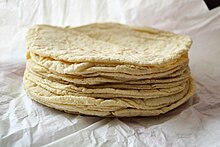|
Tortilla
A tortilla (/tɔːrˈtiːə/, Spanish: [toɾˈtiʝa]) is a thin, circular unleavened flatbread from Mesoamerica originally made from maize hominy meal, and now also from wheat flour. The Aztecs and other Nahuatl speakers called tortillas tlaxcalli ([t͡ɬaʃˈkalli]).[1] First made by the indigenous peoples of Mesoamerica before colonization, tortillas are a cornerstone of Mesoamerican cuisine. Corn tortillas in Mesoamerica are known from as early as 500 BCE. EtymologyThe word tortilla is derived from the Spanish word torta, meaning "cake," plus the diminutive -illa; as a result, the word means "little cake" in Spanish.[2][3] Varieties CornTortillas made from nixtamalized maize meal—masa de maíz— are the oldest variety of tortilla. They originated in Mexico and Central America, and remain popular throughout the Americas. Peoples of the Oaxaca region in Mexico first made tortillas at the end of the Villa Stage (1500 to 500 BCE).[4][page needed] Towards the end of the 19th century, the first mechanical utensils for making tortillas, called tortilla presses, tortilleras, or tortilladoras, were invented and manufactured in Mexico. WheatEuropeans introduced wheat and its cultivation to the American continent, and it remains the source for wheat flour tortillas. Wheat flour tortillas originated in the northern region of Mexico. Wheat tortillas usually contain fats such as oil or lard, salt, often leavening agents such as baking powder, and other ingredients. Otherwise, the preparation and cooking of flour tortillas on a comal is identical to that of corn tortillas. Flour tortillas are commonly used in dishes like burritos, tacos, and fajitas. It is part of the daily food repertoire throughout Mexico, whose gastronomy and culture has influenced those of many Central American countries and some states in the U.S. NopaltillaA nopaltilla is a cactus-corn tortilla. The word is a portmanteau of nopal, Spanish for the Opuntia ficus-indica cactus, and tortilla.[5][6] See also
References
|
||||||||||||

